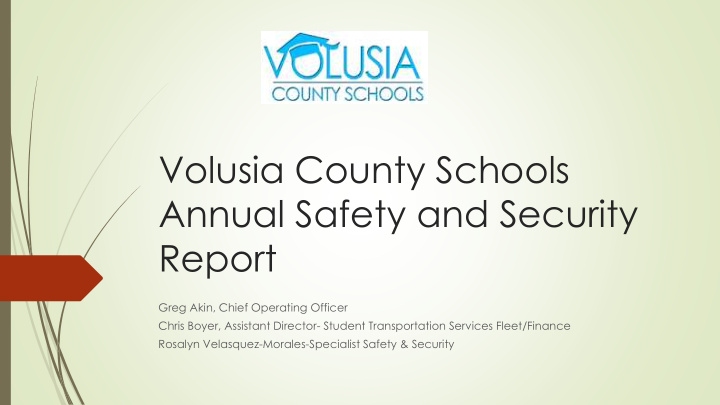



Volusia County Schools Annual Safety and Security Report Greg Akin, Chief Operating Officer Chris Boyer, Assistant Director- Student Transportation Services Fleet/Finance Rosalyn Velasquez-Morales-Specialist Safety & Security
Overview The District Safety and Security Program The Office of Program Policy Analysis and Governmental Accountability (OPPAGA) District Safety and Security Assessment Findings Discussion items: Manual, Assessment Workbook, Best Practices Assessment Schedule Statewide Tornado Drill Results Visitor Management District Events Recommendations Board Approval
Background Information The 2001 Legislature created Section 1006.07, Florida Statutes (Safety and Security Best Practices) The statute charges OPPAGA to develop the “Safety and Security Best Practices.” The Best Practices are approved by the Commissioner of Education and reviewed annually by OPPAGA and the Partnership for School Safety and Security The Best Practices continue to be revised as deemed necessary
OPPAGA Requirements and Findings Each school district is required to use the Safety and Security “Best Practices” to conduct a self - assessment of the school district’s current safety and security practices Based on these self assessment findings, the superintendent of each school district is to provide recommendations to the school board which identify strategies and activities that the school district should implement in order to improve school safety and security. Within 30 days of completing the assessment, the school board must receive the self assessment results at a publicly noticed school board meeting to provide the public an opportunity to hear school board members discuss and take action on the report findings. The district is in full compliance with the State’s requirements regarding OPPAGA Safety and Security Best Practices for Florida’s schools.
Florida Safe Schools Assessment Tool (FSSAT) -District specific processes and procedures -School information -Campus maps -Submittal to DOE
VCS Safety and Security Program Certification process Section overview (62 standards) 100 (Administrative Services) 200 (Emergency Management) 300 (Facilities) 400 (Health Services) 500 (Law Enforcement) 600 (School Food Services) 700 (Student Services) 800 (Transportation Services)
Safety and Security Manual/ Assessment Workbook/Best Practices Reviewed and revised annually Assessment Workbook Contents: Expectations for each standard including documentation requirements, observations and interviews Distribution process Sixty-two (62) standards for 2017-2018 year Best Practices on SharePoint site: District forms Roles and responsibilities templates Sample letters Sample presentations Safety and security tips
District Assessment Schedule 2017-2018 The district safety and security assessments continue to serve as a major training exercise for all schools and departments Assessments vs. site visits School Type # of Schools 2017-2018 composition Elementary 16 Middle 7 High 5 Charter 7 Alternative 1 K-8 1 Other 3
District-Wide Tornado Drill Findings January 23 rd -27 th (Severe Weather Awareness Week) All schools were evaluated this year (observed by EOC or self) Notification process Notations by EOC observers
District Wide Daily Events Total Incidents School Year 17-18 448 (through 11/30/2017) School Year 16-17 1,137 School Year 15-16 1,405 Top 5 Incident Types & Color Coded Events School Year 17-18 School Year 16-17 School Year 15-16 (through 11/30/17) Medical (74) Medical (239) Medical (256) Baker Act (43) Baker Act (98) Baker Act (144) Injury (39) Off Campus Incident (90) Injury (125) Other (36) Injury (89) Assault/Battery/Fight (96) Off Campus Incident (31) Other (69) Off Campus Incident (91) Code Red-Lockdown (7) Code Red-Lockdown (21) Code Red-Lockdown (22) Code Blue-Bomb Threat Code Green-Severe Code Blue-Bomb Threat (3) (2) Weather (2) Code Green-Severe Code Blue-Bomb Threat Code Green-Severe Weather Weather (0) (1) (1) Code Yellow-Hazmat (0) Code Yellow-HazMat (1) Code Yellow-HazMat (0)
-Module overview -Functionality -Alerts -Statistics 17-18 (106,019 visitors through 11/30/17) 16-17 (264,905 visitors) 15-16 (233,448 visitors*) *Implemented in September 2015
Last Year’s Recommendations Continue to recruit school based staff to participate on the safety and security assessment team. Recommend all school and department personnel assigned safety and security duties be required to attend one (1) of the eleven (11) training sessions being held to review the material. NIMS training class offerings expanded to nine (9) sessions throughout the school year. Change assessments to every other year for all schools and departments.
This Year’s Recommendations We will continue Best Practices to recruit school based staff to participate on the safety and security assessment team (Administration and Ed. Leadership) and provide continuous training sessions for team members. Assessment of 800 MHz radio operability within our campuses to ascertain if a communications repeater is needed for first responders. Continue to utilize the ½ cent sales tax and upgrade infrastructure as discussed in the capital outlay project listing.
Questions
Recommend
More recommend